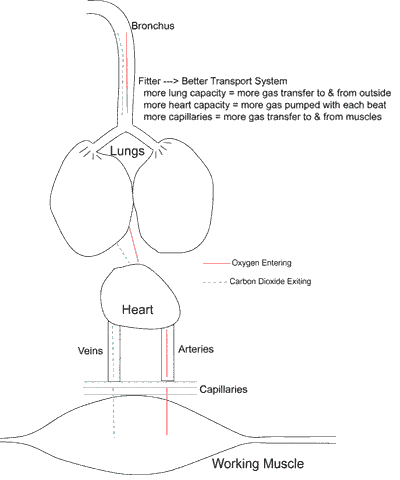
PE 9A Information
Section 3: Aerobic Fitness and Training
Tracey Kobayashi
50 Phelan Ave, NGYM
San Francisco, CA 94112
(415)452-7311
tkobayas@ccsf.edu
PE 9A: Fit or Fat
College & Career Ed
PE 50: Fitness Center

IM Me!
AIM - TKatCCSF
Yahoo - tkobico
ICQ - 155909399
Intro | Facts
Cardio | Strength
Nutrition | Diet Industry
Resources
References
Aerobic fitness is one of the best fitness measures for overall functionality. Aerobic (cardiovascular) fitness reflects the ability to take in and deliver oxygen to the working systems and eliminate carbon dioxide. The body depends on oxygen to help in metabolic processes and carbon dioxide formed during these processes must be taken away. In general, an aerobically fit person utilizes fat more readily than one who isn't.
The Cardiovascular System
During respiration, air is taken into the lungs, where it passes through alveoli (little sacs) and attaches onto hemoglobin in the blood. The heart pumps oxygenated blood through arteries to the body. The arteries lead into capillaries (small, thin-walled blood vessels) where the oxygen transfers to organelles in the the working cells called mitochondria utilize it for aerobic metabolism, creating energy, and forming carbon dioxide as a by-product. The carbon dioxide enters the vascular system back in the capillaries. The capillaries lead back to the veins which go back to the heart, which pumps the de-oxygenated blood back to the lungs where the carbon dioxide is expired.
The following schematic shows how the cardiovascular system works to bring oxygen to and carbon dioxide away from the working muscles.

Inefficiency anywhere along the line influences function. Lung capacity limits the air that can be brought in with each breath, capillaries limit oxygen and carbon dioxide exchange, mitochondria limits oxygen usage, and the heart limits how much blood can be pumped with each stroke. During high intensity work, the body becomes more acidic from by-products of anaerobic metabolism, inhibiting the blood's ability to transport oxygen to the working muscle. When this happens, the body relies more on anaerobic metabolism, but intensity level is also relative to level of fitness. If a fit person and an unfit person are walking at the same pace, the fit person could be walking at an aerobic pace, burning mostly fat, and feeling comfortable, while the unfit person works at an anaerobic pace, burning more carbohydrate, increasing acidity and reaching exhaustion quickly. Aerobic activity also has health and fitness benefits: regular activity is associated with a higher hdl:ldl ratio. HDL is the "good" cholesterol; aerobic activity utilizes fat a fuel source, helping to bring it out of storage; aerobic exercise helps improve endurance -- ability to sustain work over an extended period; regular activity helps control body composition -- achieving or maintaining a healthy lean to fat ratio.
Aerobic Activities and Training
An aerobic activity is one where cardiorespiratory and aerobic metabolism systems dominate. During an aerobic training session, respiration, cardiac output and metabolism increase to meet immediate increased energy needs, and fat is released from the adipose tissues to supply energy. Of course, it takes time for the body to release those fats, and you guessed it, a fitter person releases them more readily than a less-fit person. If we look at guidelines for aerobic exercise, we see they attempt to ensure the body releases and uses those fats by requiring continuous movement for a minimum amount of time. Common aerobic activities include walking, jogging, lap swimming, aerobic fitness classes, rowing and biking.
Aerobic training has the following training effects, which contribute to greater cardiorespiratory efficiency: heart muscle strength and elasticity increases, increasing stroke volume -- the heart does less work for the same volume output so heart rate decreases for a given workload; increased overall blood volume means more hemoglobin is available to transport oxygen to the cells; enhanced capillarization ensures more oxygen passes through to working muscles; mitochondrial development allows working systems to create energy more efficiently. In short, the body' transport and chemical control mechanisms are enhanced. These changes may be seen in an increased VO2 max and anaerobic threshold, which means that a fitter individual is a better fat burner (or glucose sparer). Depending on level of fitness when beginning the exercise program, the individual may see an improvement within the first few weeks, usually by noticing that the activity seems much easier to complete.
Aerobic training/exercise is aerobic activity following these general guidelines:
- Frequency: 3 - 5 times/week.
- Intensity: 50 - 85% of VO2 max or reserve (see Karvonen Formula). You should be able to talk, but not sing. Because you are aiming for a "systemic" response, it's best to do activities requiring large muscle groups involving at least 50% of the body's muscle mass.
- Time: 20-60min of continuous work. Extended time assures aerobic activity. Too long, however, gives diminishing returns for your output.
Individuals have different heart rates for given intensities depending upon variables as age, activity level, genetics, etc. As the body adapts, heart rate for a given intensity decreases, and the individual must work harder for the heart rate to reach the training zone.
You may be familiar with new guidelines regarding physical activity: accumulate at least 30 minutes of moderate to high intensity activity each day. Notice the total amount of weekly activity is the same -- the new guidelines allow you to break activity into smaller, more palatable chunks. Which guidelines should you use? Probably a combination. Try to increase general activity in your everyday life, and include 2-3 days of aerobic exercise each week. In general, those who want to lose weight will do more than the minimum amount of aerobic training, however, the maximums should not be exceeded.
The Karvonen Formula
The Karvonen formula is a way to determine target heart rate that consdiders your current fitness level. The formula follows this procedure: Subtract your age from 220. This is your maximum heart rate (mhr) in beats per minute. Subtract your resting heart rate (rhr) from your mhr for cardiac reserve. Find your rhr when you wake up. Multiply cardiac reserve by upper and lower percentage factors, then add rhr back in for upper and lower limits. The formulas are condensed below:
Max. Heart Rate (MHR): 220 - age
Cardiac Reserve (CR): MHR - RHR (Resting Heart Rate)
| Lower THR Limit | Upper THR Limit |
|---|---|
| (CR x 60 percent) + rhr | (CR x 80 percent) + rhr |
Intro | Facts
Cardio | Strength
Nutrition | Diet Industry
Resources
References